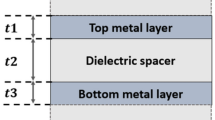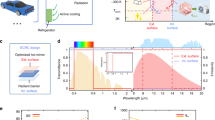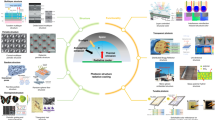Abstract
Smart windows are emerging as an effective way of minimizing energy consumption in buildings. They attracted the major relevance for minimizing energy consumption in buildings. More research studies are needed to design smart windows with operating wide range and don’t require additional energy to operate. We suggest a novel smart window structure using photonic crystal to regulate the solar radiation intensity by preventing it from penetrating the buildings in summer. For the first time, the suggested smart window photonic crystal at room temperature is proposed. The suggested smart window can block about 400 nm of near-infrared. This smart window model doesn’t require additional heat or electric input to operate.
Similar content being viewed by others
Introduction
Switchable electromagnetic wave transmittance using smart windows has recently attracted attention because they are involved in skylights, architectural or vehicle windows, and internal partition applications1. Because commercial and residential buildings consume around 40% of overall energy consumption, the implementation of smart windows is of major relevance for minimizing energy consumption in buildings2. Heating, air conditioning, and ventilation account for more than half of the total energy consumption3.
Smart windows control how much ultraviolet (UV), visible, and, most importantly, near-infrared (IR) radiation penetrates buildings. Inside facades, blinds can be used to regulate the solar radiation intensity by preventing it from penetrating the building in summer to reduce the cooling costs. The intercepted solar energy in this traditional way is not being used. Even though Photochromic, electrochromic, and thermochromic materials are chromogenic materials that have been widely used for smart windows to conserve energy, they require additional heat or electric input to operate4,5,6.
The dispersion of electromagnetic waves through periodic structures is greatly affected by the photonic band gaps (PBGs). Recently, photonic crystals (PCs) are used in different applications such as filters, biosensors, solar cells, etc.7,8,9,10,11,12,13,14,15,16,17,18,19,20,21,22,23. Currently, some advanced spatial smart windows are implemented using the spatial propagation features of traditional PCs24. Arafa et al. in 2019 presented a low-temperature smart window using superconductor PC25. Blocking or passing the electromagnetic waves in this structure is controlled by changing the incident angle. Also, it can’t be used for our buildings because it depends on the usage of superconductor material. It can be used only for low-temperature applications. In 2020, Arafa et al. proposed an optical filter structure to control the propagation of light through it depending on the incident angle26. Besides, this structure can’t record high (for winter) and low (for summer) transmitted infra-red light at the same time.
The current work is distinct in some ways. For the first time, a detailed simulation study of smart window PC at room temperature is proposed. Moreover, the proposed structure has the ability to block a wide range of IR by filling the air layers with water. It can work at a long range of incident angles. Moreover, the suggested structure doesn’t require additional heat or electric input to operate.
Basic equations and materials
Figure 1 presents the proposed smart windows. In the case of Fig. 1A, the visible electromagnetic wave will be transmitted, and IR will be blocked. It is composed of (SiO2/Air)N photonic crystal. By filling the cavity layer with water, visible and IR electromagnetic waves will be transmitted as clear in Fig. 1B. N clarifies the number of times the photonic crystal periods will be repeated. The proposed smart windows structure will be deposited on SiO2 substrate.
SiO2 layers can be deposited using different techniques such as ion assistance electronic beam deposition27 and radiofrequency magnetron sputtering28. The refractive index of SiO2 can be calculated by using the following fitted equation27:
where \({\uplambda }\) is the wavelength in µm. We use SiO2 as a dielectric material because the imaginary part is close to 0 and can be ignored27. Zaky et al.11 cleared a method that can help to control the thickness of Air/water layers during the process of fabrication using the etching process. For certainty, we assume dA = 175 nm, dB = 270 nm, N = 3, nAir = 1, nwater = 1.3329, and \(\theta_{0} =\) 0 degrees as initial conditions.
As the incident sunlight is completely unpolarized, each polarized component (TE and TM components) has its own proper behavior inside the proposed design30. The transmittance of the proposed smart windows for TE and TM electromagnetic waves will be calculated by the transfer matrix method (TMM) to investigate how the proposed smart windows react to incident waves31,32,33,34:
where
where \(\theta_{k}\), \(n_{k}\), \(a_{k} ,\) \(p_{0}\), and \(p_{s}\) are the incident angle of the electromagnetic waves, the dielectric constant, the transfer matrix element, \(p_{0} {\text{and }}p_{s}\) related to air and substrate.
Ethics approval and consent to participate
This article does not contain any studies involving animals or human participants performed by any of the authors.
Results and discussions
To demonstrate the capability of our smart window structure to control the propagation of IR range, we conducted a series of simulation studies using TMM.
For this study, we need a window that lets the visible and near IR range propagate through in winter to warm the buildings internally, and blocks IR in summer. A structure with two conditions will be used for these states, as clear in Fig. 1. In the event that the structure layers are (SiO2/Air)N, there is a high refractive index contrast between nSiO2 and nAir. As a result, a PBG appeared as clear in Fig. 2 (black line). Through the PBG, the intensity of the transmitted IR decreases and reaches a minimum value of 33% at the wavelength of 1053 nm.
By filling the air layers with water as clear in Fig. 1B, the refractive index contrast between the two used layers (nSiO2 and nwater) strongly decreases. So, the PBG disappeared at the range of wavelength of concern, as clear in Fig. 2 (red line). Then, the structure allows both visible and IR to propagate through it with high transmittance ranging from 90 to 100% and warm the buildings.
In the following studies, we will try to reduce the intensity of IR to achieve a complete blocking as possible as we can. The effect of the incident angle of TE and TM polarized light on the PBG is studied in Fig. 3 for both two conditions (nSiO2/nAir and nSiO2/nwater). In order to assess the impact of the incident angle on PBG, the transmittance of the structure versus the wavelength at different incident angles was studied for both TE and TM polarized light.
As clear in Fig. 3A, for the summer structure, the PBG is shifted to lower wavelengths with increasing the incident angle of TE polarized light according to the following relation35,36:
where P is the optical path difference, m is an integer, \(n_{eff}\) is the periodic structure's effective dielectric constant, w is the incoming light wavelength, and G is the geometrical path difference. Since the PBG at the angle of 35 degrees extended from 700 to 1300 nm with a width of 600 nm, this angle is very suitable for the proposed application. Besides, at this angle, a moderated PBG extended from 800 to 1150 nm with a width of 350 nm for TM polarized light, as clear in Fig. 3C.
For winter structure, the angle of 35 degrees also records a suitable visible and IR transmittance for TE polarized light, and high transmittance in the case of TM polarized light, as clear in Fig. 3B,C. So, we recommend this angle in the following studies.
Because the PBG is proportional to the thickness of the used materials, the PBG shifts to higher wavelengths for higher thicknesses of the air/water layer according to Eq. (7). As clear in Fig. 4A,C, with the increase of thickness, the amount of IR with high energies (low wavelengths) can be transmitted for both TE and TM polarized light. So, the thickness of dB = 270 nm will be recommended for the following study.
In Fig. 5, the number of periods will be changed but all other conditions are constants. For the summer structure, the center of PBG seems to be at the same position but the width of the PBG increases and the transmittance decreases. Besides, the edges of the PBG become more vertical and are slightly shifted to higher wavelengths. On the other hand, for winter structure, the transmittance of both TE and TM polarized light slightly decreases.
Where N = 6 has the ability to block much amount of IR in summer, it will be recommended after increasing the incident angle to 40 degrees to adjust the left edge of the PBG at the end of the visible light range and the beginning of IR range. Besides, the transmittance of unpolarized sunlight (blue line) is calculated according to the following equation30:
It is worth noting that the efficiency of the proposed smart window for blocking TE polarized light is higher than TM as clear in Fig. 6A,B.
Conclusion
We have utilized TMM simulation studies on 1D-PC as a novel smart window at room temperature. This structure recorded high efficiency for blocking a wide range of IR. The results cleared the performance of the proposed smart window and its potential for energy consumption. However, as much or more work remains to be done to improve the efficiency of smart windows to be able to block all ranges of IR and UV for indoor comfort and energy saving.
Data availability
The datasets used and/or analyzed during the current study are available from the corresponding author on reasonable request.
References
Lee, S. G. et al. Switchable transparency and wetting of elastomeric smart windows. Adv. Mater. 22, 5013–5017. https://doi.org/10.1002/adma.201002320 (2010).
Cao, D., Xu, C., Lu, W., Qin, C. & Cheng, S. Sunlight-driven photo-thermochromic smart windows. Solar Rrl 2, 1700219. https://doi.org/10.1002/solr.201700219 (2018).
Wang, S., Gao, W., Hu, X.-Y., Shen, Y.-Z. & Wang, L. Supramolecular strategy for smart windows. Chem. Commun. 55, 4137–4149. https://doi.org/10.1039/C9CC00273A (2019).
Davy, N. C. et al. Pairing of near-ultraviolet solar cells with electrochromic windows for smart management of the solar spectrum. Nat. Energy 2, 1–11. https://doi.org/10.1038/nenergy.2017.104 (2017).
Wang, J.-L., Lu, Y.-R., Li, H.-H., Liu, J.-W. & Yu, S.-H. Large area co-assembly of nanowires for flexible transparent smart windows. J. Am. Chem. Soc. 139, 9921–9926. https://doi.org/10.1021/jacs.7b03227 (2017).
Cai, G., Darmawan, P., Cheng, X. & Lee, P. S. Inkjet printed large area multifunctional smart windows. Adv. Energy Mater. 7, 1602598. https://doi.org/10.1002/aenm.201602598 (2017).
Zaky, Z. A., Sharma, A. & Aly, A. H. Gyroidal graphene for exciting tamm plasmon polariton as refractive index sensor: Theoretical study. Opt. Mater. 122, 111684. https://doi.org/10.1016/j.optmat.2021.111684 (2021).
Zaky, Z. A. & Aly, A. H. Gyroidal graphene/porous silicon array for exciting optical Tamm state as optical sensor. Sci. Rep. 11, 19389. https://doi.org/10.1038/s41598-021-98305-0 (2021).
Zaky, Z. A. & Aly, A. H. Modeling of a biosensor using Tamm resonance excited by graphene. Appl. Opt. 60, 1411–1419. https://doi.org/10.1364/AO.412896 (2021).
Zaky, Z. A., Sharma, A., & Aly, A. H. Tamm plasmon polariton as refractive index sensor excited by gyroid metals/porous Ta2O5 photonic crystal. Plasmonics 17, 681–691 (2021). https://doi.org/10.1007/s11468-021-01559-7
Zaky, Z. A., Ahmed, A. M. & Aly, A. H. Remote temperature sensor based on tamm resonance. SILICON 14, 2765–2777. https://doi.org/10.1007/s12633-021-01064-w (2021).
Zaky, Z. A., Sharma, A., Alamri, S. & Aly, A. H. Theoretical evaluation of the refractive index sensing capability using the coupling of Tamm-Fano resonance in one-dimensional photonic crystals. Appl. Nanosci. 11, 2261–2270. https://doi.org/10.1007/s13204-021-01965-7 (2021).
Aly, A. H., Sayed, H. & Elsayed, H. A. Development of the Monolayer Silicon Solar Cell Based On Photonic Crystals. SILICON 11, 1377–1382. https://doi.org/10.1007/s12633-018-9936-7 (2019).
Yablonovitch, E. Photonic crystals: semiconductors of light. Sci. Am. 285, 46–55. https://doi.org/10.1038/scientificamerican1201-46 (2001).
Wang, Y., Huang, Q., Zhu, W., Yang, M. & Lewis, E. Novel optical fiber SPR temperature sensor based on MMF-PCF-MMF structure and gold-PDMS film. Opt. Express 26, 1910–1917. https://doi.org/10.1364/OE.26.001910 (2018).
Peng, J. et al. Thin films based one-dimensional photonic crystal for humidity detection. Sens. Actuators, A 263, 209–215 (2017).
Karmakar, S., Kumar, D., Varshney, R. & Chowdhury, D. R. Strong terahertz matter interaction induced ultrasensitive sensing in fano cavity based stacked metamaterials. J. Phys. D Appl. Phys. 53, 415101. https://doi.org/10.1088/1361-6463/ab94e3 (2020).
Nayak, C., Aghajamali, A., Alamfard, T. & Saha, A. Tunable photonic band gaps in an extrinsic Octonacci magnetized cold plasma quasicrystal. Physica B 525, 41–45. https://doi.org/10.1016/j.physb.2017.08.075 (2017).
Nayak, C., Aghajamali, A. & Saha, A. Double-negative multilayer containing an extrinsic random layer thickness magnetized cold plasma photonic quantum-well defect. Superlattices Microstruct. 111, 248–254. https://doi.org/10.1016/j.spmi.2017.06.041 (2017).
Aly, A. H. et al. Detection of reproductive hormones in females by using 1D photonic crystal-based simple reconfigurable biosensing design. Crystals 11, 1533. https://doi.org/10.3390/cryst11121533 (2021).
Zaky, Z. A., Panda, A., Pukhrambam, P. D. & Aly, A. H. The impact of magnetized cold plasma and its various properties in sensing applications. Sci. Rep. 12, 3754. https://doi.org/10.1038/s41598-022-07461-4 (2022).
Zaky, Z. A., Amer, H. A., Suthar, B. & Aly, A. H. Gas sensing applications using magnetized cold plasma multilayers. Opt. Quant. Electron. 54, 217. https://doi.org/10.1007/s11082-022-03594-y (2022).
Zaky, Z. A., Singh, M. R., Aly, A. H. Tamm resonance excited by different metals and graphene. Photon. Nanostruct. Fundam. App. 49, 100995 (2022). https://doi.org/10.1016/j.photonics.2022.100995
Aly, A. H., Ameen, A. A., Elsayed, H. A., Mohamed, S. & Singh, M. R. One-dimensional metallo-superconductor photonic crystals as a smart window. J. Supercond. Novel Magn. 32, 2313–2318. https://doi.org/10.1007/s10948-018-4978-z (2019).
Aly, A. H., Ameen, A. A. & Vigneswaran, D. Superconductor nanometallic photonic crystals as a novel smart window for low-temperature applications. J. Supercond. Novel Magn. 32, 191–197. https://doi.org/10.1007/s10948-018-4716-6 (2019).
Aly, A. H., Ahmed, A. M. & Shaban, M. Multilayer angular optical filter as a smart window. Indian J. Phys. 94, 95–103. https://doi.org/10.1007/s12648-019-01438-2 (2020).
Gao, L., Lemarchand, F. & Lequime, M. Exploitation of multiple incidences spectrometric measurements for thin film reverse engineering. Opt. Express 20, 15734–15751. https://doi.org/10.1364/OE.20.015734 (2012).
Jena, S. et al. Omnidirectional photonic band gap in magnetron sputtered TiO2/SiO2 one dimensional photonic crystal. Thin Solid Films 599, 138–144. https://doi.org/10.1016/j.tsf.2015.12.069 (2016).
Hale, G. M. & Querry, M. R. Optical constants of water in the 200-nm to 200-μm wavelength region. Appl. Opt. 12, 555–563. https://doi.org/10.1364/AO.12.000555 (1973).
Luque-Raigón, J. M., Halme, J. & López-López, C. Angular optical behavior of photonic-crystal-based dye-sensitized solar cells. J. Photon. Energy 9, 025501. https://doi.org/10.1117/1.JPE.9.025501 (2019).
Yeh, P. Optical Waves in Layered Media: Wiley, New York (1988).
Born, M. & Wolf, E. Principles of Optics: Electromagnetic Theory of Propagation, Interference and Diffraction of Light. Elsevier (2013).
Zaky, Z. A. & Aly, A. H. Highly sensitive salinity and temperature sensor using tamm resonance. Plasmonics 16, 2315–2325. https://doi.org/10.1007/s11468-021-01487-6 (2021).
Zaky, Z. A., Aly, A. H. & Moustafa, B. Plasma cell sensor using photonic crystal cavity. Opt. Quant. Electron. 53, 591. https://doi.org/10.1007/s11082-021-03201-6 (2021).
Zaky, Z. A., Sharma, A., Alamri, S., Saleh, N. & Aly, A. H. Detection of fat concentration in milk using ternary photonic crystal. Silicon (2021). https://doi.org/10.1007/s12633-021-01379-8
Zaky, Z. A., Ahmed, A. M., Shalaby, A. S. & Aly, A. H. Refractive index gas sensor based on the Tamm state in a one-dimensional photonic crystal: Theoretical optimisation. Sci. Rep. 10, 9736. https://doi.org/10.1038/s41598-020-66427-6 (2020).
Acknowledgements
The authors thank the reviewers and editors for improving this article.
Funding
Open access funding provided by The Science, Technology & Innovation Funding Authority (STDF) in cooperation with The Egyptian Knowledge Bank (EKB). The authors declare no fund.
Author information
Authors and Affiliations
Contributions
Z.A.Z. invented the original idea of the study, implemented the computer code, performed the numerical simulations, analyzed the data, wrote and revised the main manuscript text. A.H.A. discussed the results and supervised this work. All Authors developed the final manuscript.
Corresponding author
Ethics declarations
Competing interests
The authors declare no competing interests.
Additional information
Publisher's note
Springer Nature remains neutral with regard to jurisdictional claims in published maps and institutional affiliations.
Rights and permissions
Open Access This article is licensed under a Creative Commons Attribution 4.0 International License, which permits use, sharing, adaptation, distribution and reproduction in any medium or format, as long as you give appropriate credit to the original author(s) and the source, provide a link to the Creative Commons licence, and indicate if changes were made. The images or other third party material in this article are included in the article's Creative Commons licence, unless indicated otherwise in a credit line to the material. If material is not included in the article's Creative Commons licence and your intended use is not permitted by statutory regulation or exceeds the permitted use, you will need to obtain permission directly from the copyright holder. To view a copy of this licence, visit http://creativecommons.org/licenses/by/4.0/.
About this article
Cite this article
Zaky, Z.A., Aly, A.H. Novel smart window using photonic crystal for energy saving. Sci Rep 12, 10104 (2022). https://doi.org/10.1038/s41598-022-14196-9
Received:
Accepted:
Published:
DOI: https://doi.org/10.1038/s41598-022-14196-9
This article is cited by
-
Theoretical optimisation of a novel gas sensor using periodically closed resonators
Scientific Reports (2024)
-
Analysis and design of photonic crystal malaria biosensor with double nanohole cavity resonator with ultra-high-quality factor
Optical and Quantum Electronics (2024)
-
Design of phononic crystal using open resonators as harmful gases sensor
Scientific Reports (2023)
-
Theoretical optimization of Tamm plasmon polariton structure for pressure sensing applications
Optical and Quantum Electronics (2023)
-
Tunable bidirectional perfect THz absorber realized by graphene-based one-dimensional photonic crystals
Optical and Quantum Electronics (2023)
Comments
By submitting a comment you agree to abide by our Terms and Community Guidelines. If you find something abusive or that does not comply with our terms or guidelines please flag it as inappropriate.









